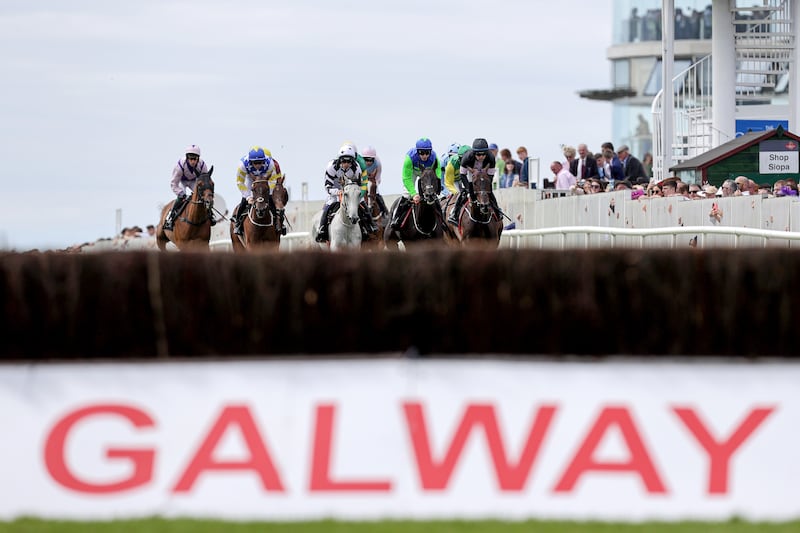The old gag about nostalgia not being what it used to be doesn’t deflect from how, in an increasingly turbulent racing world, next week’s Galway festival is reassurance that some things don’t change.
It’s officially the 155th year of racing at Ballybrit and for almost as long as that questions have been asked as to why the festival remains the most distinctive jewel in Irish racing’s crown.
John B Keane famously said “the Galway races are a state of mind. Indeed they are, a state of mind that is distinctly Irish. Often copied but never equalled”.
A YouTube clip of a news report from 1977 saw then track manager Captain Luke Mullins, brother of the legendary Paddy, and uncle of Willie, talk in terms of history even then.
READ MORE
“I suppose it’s the tradition. We’re 109 years in Ballybrit. 109 years is a long time,” he said. Another contributor referred to late night extensions in the city and Salthill and everyone getting into “the swing of things” at the place to be.
Take away the visuals and those words could be lifted directly into more contemporary explanations as to why the Galway festival continues to be as much a fixture of Ireland’s summer schedule as 99s and grousing about how the weather is nowhere as nice as it used to be.
If the racecourse itself has been transformed since then, the festival is still a ritual for so many people who ordinarily have little interest in racing. It might have manifested itself in more vulgar terms during the infamous Fianna Fáil tent years, yet it remains an observable public ‘event’.
Just as the festival is a barometer of the wider social mood, there’s a self-perpetuating element to it too, although just how on-trend it will be this year could be determined by the outcome of Sunday’s All-Ireland football final.
The prospect of a Galway victory over Armagh, accompanied by a weather outlook holding out the prospect of some rare sunshine, will have more than just racecourse officials keeping everything crossed next week’s action maintains momentum from 2023.
An official attendance of 122,362 was returned for the seven days a year ago, an increase of over 5,600 on 2022. That was close to 10 per cent of the overall attendance reported by Horse Racing Ireland throughout 2023. It might have been more only for dreadful weather on the Friday.
It was an upswing that arrested a worrying slide in attendance levels over much of the previous decade. The official crowd figure for 2015 was almost 149,000. By 2022, and on the back of two years of behind closed doors festivals due to the pandemic, it dipped to 116,720.
All of it is still far removed from the height of Celtic Tiger madness that saw almost 217,00 crammed into Ballybrit in 2006. The renowned Galway betting ring too is a faint facsimile of when it financially charged much of the sport with huge turnover of cash taking place.
But despite digital modernity, and a vastly more competitive wider leisure market, Galway still exerts a unique hold on the popular imagination, a restoring shot of what the sport used to be. It’s retro racing if you like, back to the days when being on the ground taking in the sights and smells was pretty much the only way to watch the sport.
Modern racing is mostly a second-hand screen experience. Much of the sport’s financial model is built on it. The sale of media rights, with pictures beamed into betting shops and streamed online, is worth about €47 million a year. And the upside is that wherever you are in the world, any race is accessible through a couple of clicks on your phone.
In such an environment it’s no surprise how most meetings are all but deserted on the ground apart from those paid to be there. Racecourses have effectively become profitable studios pumping out pictures for gambling from the comfort of wherever you want to be.

The result is a fixture list expanded to accommodate hugely profitable ‘industry’ meetings, with eight-race cards the norm’ rather than an exception, and footfall through the turnstiles a mostly superfluous consideration.
Despite all the extra fixtures, official attendance figures of just over 1.2 million last year are down from nearly 1.4 million 20 years ago. But in such a transformed environment they could be worse, and they reflect the sustained appeal of the sport’s major festivals.
Galway is the most enduringly idiosyncratic of them all. It doesn’t have the quality element of February’s Dublin Racing Festival, Punchestown in Spring, or the Champions Festival in September. Much of the actual racing is ordinary. It shouldn’t work. But it obviously does.
Maybe it really is the history, or an excuse to go on the batter in Salthill for a week. It’s certainly helped by a level of mainstream media attention other more glamorous or valuable dates can only dream of. But integral to all of it is people through the gates, turning the sport into first-hand theatre rather than just another set of pictures.
Something for the Weekend
Fans of the old Fast Show series will be all over Scorchio (6.00) at Cork this evening. The filly is back over the course and distance where she beat Kendall Roy in May and Wesley Joyce’s 5lb claim adds to her chance.
Tomorrow’s King George at Ascot promises a heavyweight head-to-head between Ballydoyle’s Auguste Rodin and Godolphin’s Rebel’s Romance, both rated on 123. By any measure though a 12lb concession to the sole three-year-old Sunway (3.40) is significant.
Only four three-year-olds have won the all-aged highlight in the last 20 years. But after his improved runner-up effort to Los Angeles in the Irish Derby, Sunway looks a significant presence, as is James Doyle prepared to do the necessary 8.12.

















